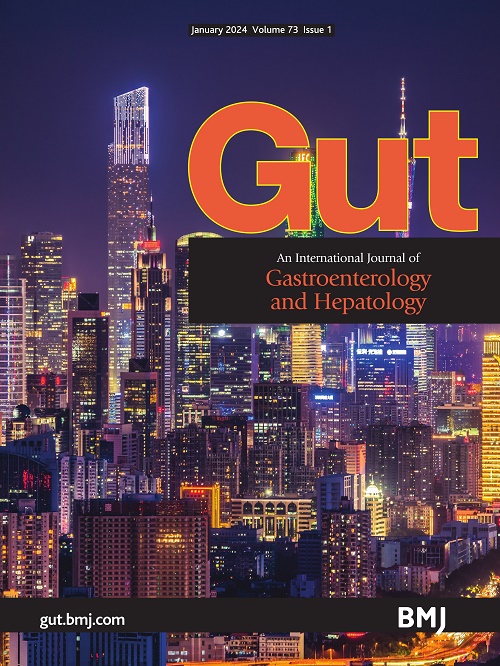Child-Pugh-Turcotte B 和 C 患者的高危静脉曲张:考虑使用卡维地洛进行带状结扎以防止首次静脉曲张出血,尤其是 MASLD 相关性肝硬化患者
IF 23
1区 医学
Q1 GASTROENTEROLOGY & HEPATOLOGY
引用次数: 0
摘要
国际指南建议,肝硬化患者静脉曲张的一级预防治疗应采用非选择性β-受体阻滞剂(NSBB)或静脉曲张带结扎术(VBL)。这些建议基于包括代偿期和失代偿期患者的研究。值得注意的是,欧洲肝脏研究协会 2018 年指南认识到 NSBB 治疗失代偿期肝硬化患者的疗效存在差距。1 Baveno 指南建议防止腹水和高危静脉曲张患者(大静脉曲张 >5 mm,或有红斑征象,或 Child-Pugh-Turcotte (CPT-C))进一步失代偿,传统 NSBB 或卡维地洛优于 VBL。美国肝病研究协会指南支持使用 NSBBs 或 VBL 治疗大面积高危静脉曲张。3 然而,最近的一项带网络荟萃分析的系统综述表明,与 NSBBs 相比,VBL 与更高的并发症和死亡率风险相关。4 这些建议的支持性证据有限,目前仍不清楚相同的治疗方案或联合疗法对失代偿期肝硬化(CPT B 或 C)是否更有效。5 该研究比较了卡维地洛、VBL 和二者的组合,以预防 CPT- B/C 肝硬化(C-13 以下)和高危食管静脉曲张(>5 毫米或 <5 毫米伴有红色征象)患者的首次静脉曲张出血。作者排除了有卡维地洛禁忌症、肝细胞癌、门静脉血栓形成、血小板计数<30000/µL、正在接受治疗性抗凝剂的患者,或曾接受过VBL或经颈静脉肝内门体分流术(TIPS)的患者。他们共招募了330名患者(每组110名)...本文章由计算机程序翻译,如有差异,请以英文原文为准。
High-risk varices in patients with Child-Pugh-Turcotte B and C: consider band ligation with carvedilol for preventing first variceal bleeding, especially in patients with MASLD-associated cirrhosis
International guidelines recommend that primary prophylaxis of varices in patients with cirrhosis be either non-selective beta-blockers (NSBBs) or variceal band ligation (VBL). These recommendations are based on studies that include both compensated and decompensated patients. Notably, the European Association for the Study of the Liver 2018 guidelines recognise a gap in the efficacy of NSBB therapy for patients with decompensated cirrhosis.1 The Baveno guidelines recommend preventing further decompensation in patients with ascites and high-risk varices (large varices >5 mm, or with red spot signs, or Child-Pugh-Turcotte (CPT-C)), with traditional NSBBs or carvedilol preferred over VBL.2 The American Association for the Study of Liver Diseases guidelines support NSBBs or VBL for large high-risk varices.3 However, a recent systematic review with network meta-analysis indicated that VBL is associated with higher risks of complications and mortality compared with NSBBs.4 The supporting evidence for these recommendations is limited, and it remains unclear whether the same treatment options or combination therapies are more effective in decompensated cirrhosis (CPT B or C). In Gut , Tevethia et al report the results of the CAVARLY trial.5 The study compared carvedilol, VBL and a combination of both for preventing the first variceal bleed in patients with CPT- B/C cirrhosis (up to C-13) and high-risk oesophageal varices (>5 mm or <5 mm with red signs). The authors excluded patients with contraindications to carvedilol, hepatocellular carcinoma, portal vein thrombosis, platelet count <30 000 per µL, those on therapeutic anticoagulation, or with previous VBL or transjugular intrahepatic portosystemic shunt (TIPS). They enrolled 330 patients (110 for each arm) …
求助全文
通过发布文献求助,成功后即可免费获取论文全文。
去求助
来源期刊

Gut
医学-胃肠肝病学
CiteScore
45.70
自引率
2.40%
发文量
284
审稿时长
1.5 months
期刊介绍:
Gut is a renowned international journal specializing in gastroenterology and hepatology, known for its high-quality clinical research covering the alimentary tract, liver, biliary tree, and pancreas. It offers authoritative and current coverage across all aspects of gastroenterology and hepatology, featuring articles on emerging disease mechanisms and innovative diagnostic and therapeutic approaches authored by leading experts.
As the flagship journal of BMJ's gastroenterology portfolio, Gut is accompanied by two companion journals: Frontline Gastroenterology, focusing on education and practice-oriented papers, and BMJ Open Gastroenterology for open access original research.
 求助内容:
求助内容: 应助结果提醒方式:
应助结果提醒方式:


